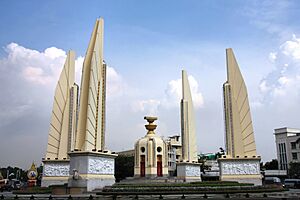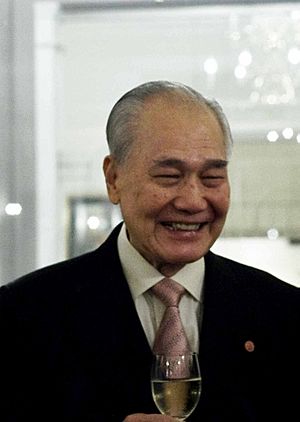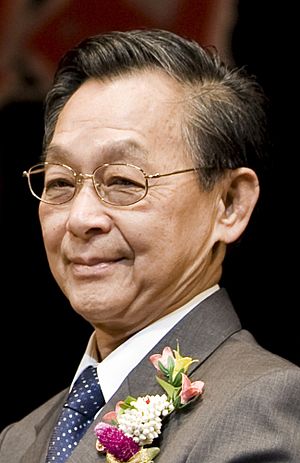History of Thailand (1973–2001) facts for kids
The history of Thailand from 1973 to 2001 was a time of big changes. Thailand tried to be a democracy, but sometimes the military took control again. This happened after a bloody event in 1976. Before that, in 1973, a student uprising had removed the old military rulers.
For most of the 1980s, Thailand was led by Prime Minister Prem Tinsulanonda. He was a strong leader who helped bring back parliamentary politics and democracy. After his time, Thailand mostly stayed a democracy, except for a short period of military rule from 1991 to 1992.
Between 1985 and 1994, Thailand's economy grew faster than almost any other country. Money from other countries, especially Japan, helped Thailand become a major place for making goods in Southeast Asia.
Later, a big money problem called the 1997 Asian financial crisis hit Thailand. This led to a new leader, Thaksin Shinawatra, winning the election in 2001.
Contents
Student Uprising and New Democracy (1973–1976)
The events of October 1973 were a huge turning point in Thai politics. For the first time, regular people, especially students, stood up against the ruling military government. They even got the support of King Bhumibol Adulyadej to move towards democracy. The military leaders had to leave the country.
However, Thailand was not yet ready for this new democracy to work easily. Elections in 1975 and 1976 did not create strong governments. Leaders like Seni Pramoj and his brother Kukrit Pramoj took turns leading, but they could not make big changes. When oil prices went up in 1974, it caused money problems and made the government weaker. One popular thing the democratic government did was to make American soldiers leave Thailand.
Around this time, communist groups in the countryside became more active. They joined with students and thinkers in the cities.
In 1975, nearby countries like South Vietnam, Laos, and Cambodia came under communist rule. This made many people in Thailand worried. When communist governments appeared on Thailand's borders, and many refugees came from Laos and Cambodia, public opinion in Thailand shifted to the right. This meant more conservative groups did better in the 1976 elections.
Military Takes Control Again (1976–1980)
By late 1976, many middle-class people were tired of the students' strong protests, which seemed to be moving towards left-wing ideas. The army and right-wing groups started saying that student activists were 'communists'. They used groups like the Nawaphon and the Red Gaurs to spread these ideas, and some students were even killed. Things got very tense in October when former military leader Thanom Kittikachorn came back to Thailand.
Workers and factory owners also had strong disagreements as people fought for their rights after 1973. Ideas like socialism became popular among thinkers and workers. The political mood became very tense. Some workers were found dead after protesting a factory owner. A strong anti-communist feeling spread across Thailand. Anyone who protested could be accused of being part of a communist plan.
In 1976, student protesters gathered at Thammasat University. They were protesting the violent deaths of workers. The next day, some newspapers, including the Bangkok Post, showed a changed photo that made it look like the protesters had disrespected the King. Right-wing leaders like Samak Sundaravej strongly criticized the protesters. This led to violence, ending in the 6 October 1976 Massacre. The army used special groups, and a mob attacked, killing many people.
That same evening, a military group took power in a coup. They ended the government led by the Democrat Party. The army put Thanin Kraivichien, a very conservative former judge, in charge as prime minister. He removed many people from universities, the media, and government jobs. Thousands of students and thinkers fled Bangkok and joined the Communist Party of Thailand in the north and northeast. Others went to live in other countries. The economy also faced serious problems because of Thanin's policies, which scared away foreign investors.
This new government was also not stable. In March 1977, one part of the army tried to take power but failed. In October 1977, another part of the army took control and replaced Thanin with General Kriangsak Chomanand. In 1978, the government offered to forgive Thai communists if they would "work with us to build a strong nation." This offer included homes, family reunions, and safety.
Around this time, Thai forces had to deal with the situation after Vietnam invaded Cambodia. More refugees arrived, and both Vietnamese and Khmer Rouge soldiers sometimes crossed into Thailand. This caused fights along the borders. In 1979, a visit to Beijing led to Deng Xiaoping agreeing to stop supporting Thailand's communist movement. In return, Thailand agreed to give a safe place to Khmer Rouge forces escaping after the invasion of Cambodia. When people learned about the terrible things the defeated Khmer Rouge had done, communism became much less popular in Thailand. Kriangsak's position as prime minister became difficult, and he had to step down in February 1980 because of economic problems. General Prem Tinsulanonda, a loyal supporter of the King and known for being honest, took over as prime minister.
Border Fights with Vietnam (1979–1988)
Between 1979 and 1988, Vietnamese soldiers in Cambodia sometimes entered Thai land. They said they were looking for rebel fighters hiding in refugee camps. Many Laotian and Vietnamese refugees had also settled there. Small fights continued along the border from 1985 to 1988. Vietnamese troops sometimes crossed the border to destroy Khmer Rouge camps in Thailand. Thailand, along with China, supported the Khmer Rouge fighters. Sometimes, these fights led to direct battles with the Royal Thai Army, which pushed the intruders back.
The Prem Years (1980–1988)
Most of the 1980s saw Thailand slowly become more democratic. King Bhumibol and Prem Tinsulanonda guided this process. They both preferred rule by law and worked to stop violent military takeovers.
In April 1981, a group of younger army officers, known as the "Young Turks," tried to take power in a coup. They took control of Bangkok. They ended the National Assembly and promised big social changes. But their plan quickly failed when Prem Tinsulanonda went with the royal family to Khorat. With King Bhumibol's clear support for Prem, loyal army units were able to take back the capital almost without bloodshed.
This event made the monarchy even more respected. It also made Prem seem like a calm and fair leader. A solution was found. The communist uprising ended, and most of the former student fighters returned to Bangkok under a special forgiveness program. In December 1982, the Thai army chief accepted the flag of the Communist Party of Thailand in a public ceremony. Here, communist fighters gave up their weapons and promised loyalty to the government. Prem announced that the armed struggle was over. The army went back to its bases. A new constitution was created, setting up an appointed Senate to balance the elected National Assembly. Elections were held in April 1983. Prem, now acting as a civilian politician, won a large majority in the government. This way of governing became known as "Premocracy."
Prem also benefited from Thailand's fast-growing economy. After a slowdown in the mid-1970s, the economy really took off. For the first time, Thailand became an important industrial country. Manufactured goods like computer parts, clothes, and shoes became Thailand's main exports, replacing rice, rubber, and tin. With the wars in Indochina and the communist uprising over, tourism grew quickly and became a major source of income. More people moved to cities, but the overall population growth slowed down. This led to better living standards even in rural areas, though the Isaan region still lagged behind. While Thailand did not grow as fast as the "Four Asian Tigers" (Taiwan, South Korea, Hong Kong, and Singapore), it had steady growth. By 1990, the average income per person was about $7100, which was double the 1980 average.
Prem was in office for eight years. He survived another coup attempt in 1985 and two more general elections in 1983 and 1986. He remained popular, but as democracy returned, people wanted a more active leader. In 1988, new elections brought former General Chatichai Choonhavan to power. Prem turned down offers from major political parties to serve a third term as prime minister.
Bloody May (1988–1992)
Chatichai's government allowed one part of the military to get rich from government deals. This angered a rival group, led by Generals Sunthorn Kongsompong and Suchinda Kraprayoon. They staged a coup in February 1991. They said Chatichai's government was corrupt. This military group called itself the National Peace Keeping Council. The NPKC put a civilian, Anand Panyarachun, in charge as prime minister, but he still had to answer to the military. Anand's efforts to fight corruption and his honest actions were popular. Another general election was held in March 1992.
The winning group of parties chose coup leader Suchinda Kraprayoon to become Prime Minister. This broke a promise he had made earlier to King Bhumibol. It also confirmed what many people suspected: that the new government would really be military rule in disguise. However, Thailand in 1992 was different from earlier times. Suchinda's action brought hundreds of thousands of people into the streets of Bangkok. These were the biggest protests ever seen in the city, led by the former governor of Bangkok, Major-General Chamlong Srimuang.
Suchinda brought military units loyal to him into the city and tried to stop the protests by force. This led to a massacre and riots in the heart of Bangkok, where many people died. Rumors spread that there was a split within the armed forces. With fears of a civil war, King Bhumibol stepped in. He called Suchinda and Chamlong to a meeting that was shown on TV. He urged them to find a peaceful solution. After this meeting, Suchinda resigned.
The People's Constitution (1992–1997)
King Bhumibol again appointed Anand as a temporary prime minister until new elections could be held in September 1992. These elections brought the Democrat Party under Chuan Leekpai to power. This party mainly represented voters from Bangkok and the south. Chuan was a good leader and stayed in power until 1995. Then, he was defeated in elections by a group of conservative parties led by Banharn Silpa-Archa. Banharn's government faced corruption accusations from the start and had to call early elections in 1996. In those elections, General Chavalit Yongchaiyudh's New Aspiration Party won by a small margin.
The 1997 Constitution was special because it was the first one written by a group of people chosen by the public. It was often called the "people's constitution." This constitution created a two-part government body: a 500-seat House of Representatives and a 200-seat Senate. For the first time in Thailand's history, people directly voted for members of both parts.
Many human rights were clearly stated in this constitution. It also put in place ways to make elected governments more stable. The House members were chosen by a "first past the post" system, where the person with the most votes in an area won. The Senate members were chosen based on provinces, with bigger provinces having more senators.
The two parts of the National Assembly have different terms. The Senate members serve for six years, while the House members serve for four years. The National Assembly usually meets in two sessions each year: an "ordinary session" and a "legislative session." The first meeting of the National Assembly must happen within 30 days after the House of Representatives is elected. The King officially opens this first meeting by reading a speech. He can also ask the crown prince or another representative to do this. It is also the King's job to officially end sessions when the House term finishes. The King can also call special meetings or make sessions longer if the House of Representatives advises it.
The National Assembly can hold a "joint-sitting" where both Houses meet together for certain reasons. These include: choosing a regent (someone who rules if the King cannot), changing the 1924 Palace Law of Succession, opening the first session, announcing policies by the Cabinet of Thailand, approving a declaration of war, hearing explanations and approving a treaty, and changing the Constitution.
The 1997 People's Constitution also protected human rights more than any other constitution before it. The court system included a constitutional court that decided if laws and government actions followed the constitution.
Money Problems and New Leadership (1997–2001)
Soon after becoming prime minister, Chavalit faced the Asian Financial Crisis in 1997. Many people criticized how he handled the crisis, so Chavalit resigned in November 1997. Chuan then returned to power. Chuan made a deal with the International Monetary Fund (IMF) that helped stabilize Thailand's money and allowed the IMF to help the economy recover. Unlike past times, this crisis was solved by civilian leaders using democratic methods.
During the 2001 election, Chuan's deal with the IMF and his use of money to help the economy were big topics of discussion. Meanwhile, Thaksin Shinawatra's ideas appealed to many voters. Thaksin campaigned strongly against old politics, corruption, and organized crime. In January 2001, he won a huge victory in the elections. He received more public support (40%) than any Thai prime minister had ever gotten in a free election.
See also
- History of Thailand (1932–73)
- History of Thailand since 2001





